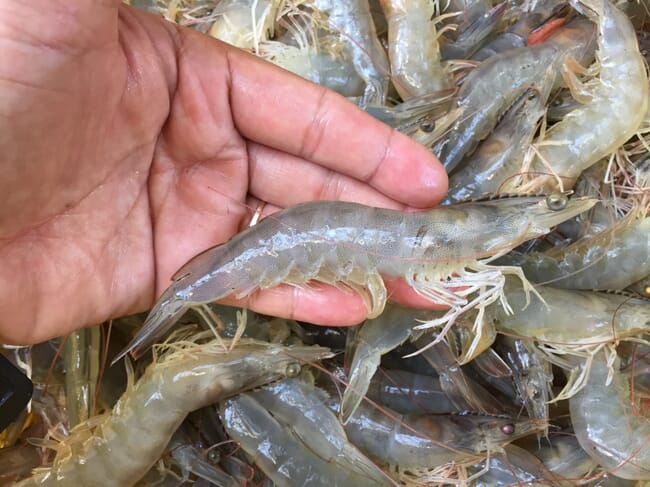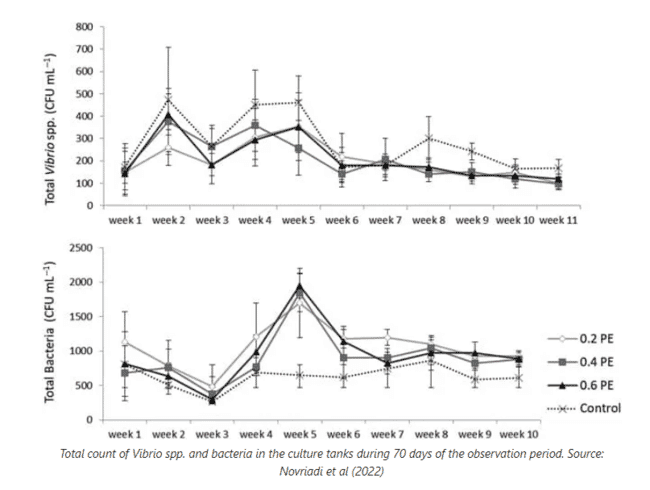
Shrimp farmers are beginning to adopt probiotics during the farm cycle as the bacteria can help improve water quality and feed uptake in shrimp
As stocking densities in intensive shrimp farms increase, farms must contend with greater risks of disease outbreaks and transmission, as well as deteriorating water quality during the farm cycle. These conditions are stressful for the shrimp and can lead to high mortality rates and substantial economic losses.
To combat these challenges, shrimp farmers are increasingly turning to probiotics. These bacteria act as a prophylactic tool as they can help improve water quality and improve nutrient utilisation in the shrimps’ digestive system. Though this makes probiotics seem like a panacea, researchers have learned that they need to be applied properly to see production benefits. In addition to optimising probiotic application, emerging research suggests that including exogenous enzymes to the culture system can yield benefits as well – but researchers aren’t aware of the impacts of using the two strategies in tandem.
To test this, researchers from Jakarta Technical University of Fisheries, National Research and Innovation Agency, PT Sinergi Samudera Biru and Biomin Holding GmbH evaluated the efficacy of feeding multispecies commercial probiotics, enzymes and the fermentation process on the growth parameters and culture environment of Pacific white shrimp (Litopenaeus vannamei), in an intensive cultivation system.
Multispecies probiotics and enzymes
For this trial, researchers continuously applied commercial multispecies probiotics and enzymes at three different doses (0.2, 0.4 and 0.6 mg/L) during the first 30 days of intensive culture of Pacific white shrimp. The probiotics were applied every alternate day, while the enzymes were added to the culture system every six days during the experimental period.
"The results show that the group that received 0.6 mg/L of probiotic + enzyme presented the highest final biomass, the highest average weight and the best protein retention rate, as well as a lower feed conversion rate, in comparison with the control group,” the researchers report.
According to the study results, the 0.6 PE group had an 8 percent higher final biomass and an 11 percent higher final average weight. In addition, the feed conversion rate was 7.4 percent lower compared to the control treatment and the protein retention rate was 13 percent higher in shrimp treated with 0.6 PE.
Likewise, the abundance of Vibrio spp. remained below 103 cfu/mL throughout the test. The water quality indicators, TAN, NO₂N and NO₃N, reached peak values in weeks three to five and then decreased until the end of the culture period in all tanks. This decline was significantly faster in the probiotic + enzyme treated shrimp tanks.

Effectiveness of commercial probiotics
“The present study demonstrated the effectiveness of commercial probiotics, containing Bacillus sp, Enterococcus sp, Pediococcus sp, Thiobacillus sp and Paracoccus sp in combination with an enzyme cocktail to increase shrimp growth and the productivity of the culture environment,” the researchers reported.
According to the study, the results demonstrate that the continuous application of multispecies probiotics and enzymes can reduce the total number of Vibrio spp., in culture environments.
Previous studies have found that probiotics can inhibit the growth of a wide variety of opportunistic bacteria, including Vibrio spp. and reduce the prevalence of viruses.
The culture density used in the growth test was 500 PL/m², so it can be defined as an intensive culture system. In this type of cultivation, applying appropriate management strategies are essential to ensure feed optimisation, which also affects farm productivity.
The researchers believe that because the shrimp digestive system is particularly activated in the larval and early postlarval stages, the use of additional protease, xylanase, cellulase and amylase enzymes could have a synergistic effect, which in turn could explain the better growth and protein composition of shrimp treated with probiotics and enzymes during the culture period.
"Multispecies probiotics and enzymes have potential applications to control Vibrio spp, maintain good water quality conditions and increase shrimp growth in intensive culture systems," the researchers conclude.
Based on the results of the study, for intensive shrimp culture systems, multispecies probiotics and enzymes should be applied at 0.6 mg/L for the first 30 days, 0.8 mg/L until day 60, and 1.0 mg/L until harvest. This will help stimulate better productivity, control of Vibrio spp. and the maintenance of good water quality conditions in intensive cultivation environments.




